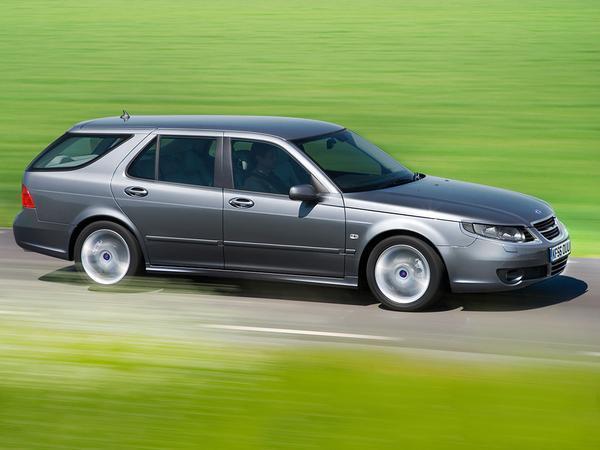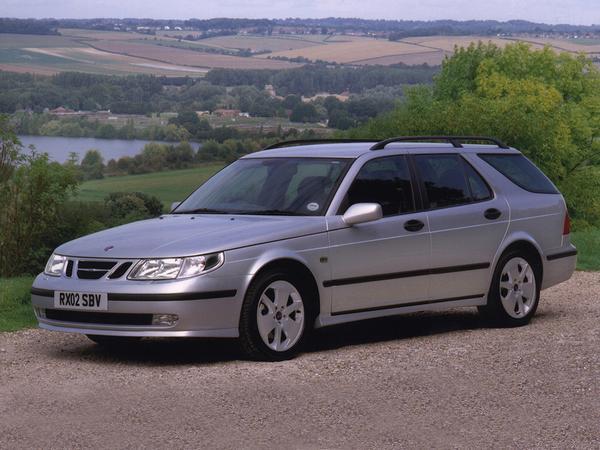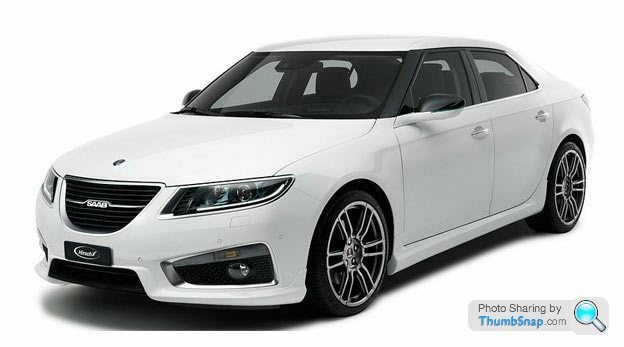Saab 9-5 | Shed Buying Guide
Saab sold the first generation Saab 9-5 for over a decade. Ten years later, it's Shed gold

Shame about Saab. Let's blame the Americans.
Those two sentiments can often be found hand in hand, with many Saab fans blaming the sad demise of this great name on General Motors. It's certainly true that GM's involvement in Saab - a 50 per cent shareholding taken up in 1989 and increased to 100 per cent in 2000, when GM also signed a big joint venture deal with Fiat - didn't turn out the way either side might have hoped. A recession allied to expensive GM employee welfare problems in the first half of the 2000s kiboshed the Fiat partnership and a lot of exciting-sounding Saab projects, and GM's attempts to make money out of Saab-badged rehashes of the Subaru Impreza and a Chevrolet SUV flopped horribly.
If some of those binned Saab projects had been allowed to go ahead (including an all-new 9-5 based on the Alfa 159 'Premium' platform, scheduled for 2005), maybe the Trollhattaners would be on a par with their Swedish rivals Volvo today. We'll never know. What we do know is that Saab went bust at the end of 2011, a year after the final YS3G model 9-5 was released. Styled on the Aero X concept and built on GM's Epsilon II platform, the YS3G apparently achieved the highest pre-sale customer clinic scores of any GM car ever, with folk seeing it as a 'highly appealing' and 'innovative' alternative to the Audi A6.
Unfortunately the new 9-5 never managed to establish itself, dying prematurely in 2012 after GM blocked a proposed deal between Saab's new owners Spyker and a Chinese consortium.
Today you can pick up a 2010 YS3G 9-5 for under £5k, and there was a 300hp 4WD version too, both of which are interesting thoughts, but even £5k is somewhat beyond our Shedly purse. No matter, though, because the previous model, the first-gen YS3E that ran from 1998 to July 2009 in saloon and estate forms, has always been a brilliant Shed choice. Roomy, comfy, and well protected against rust, the front-wheel drive 9-5 combines strong performance (either standard or tuned) with great safety and more than acceptable fuel economy. The Estate in particular is a dream for many a practicality-minded skinflint PH barger.

The gen-one 9-5 (bundling up the 1997-2001 car with the lightly facelifted 2001/2-2005 model) came with a choice of petrol and diesel engines, all of them turbocharged, and all of them - bar the auto-only 3.0 V6 petrol and the manual-only 3.0 TiD diesel - available with a choice of manual or automatic gearboxes.
That big Isuzu-engined diesel didn't arrive in the UK until 2002 and was never a huge hit here. It only came with a manual box because the existing auto box didn't fit: a properly developed auto was meant to come with the gen-two that was supposed to arrive in 2005 (but didn't, see above). As such, the 3.0 TiD's traction control warning light spent most of its life illuminated.
The 2.0- and 2.3-litre petrol fours - based on an old Triumph motor, incidentally - produced 150 and 185hp respectively. The first entry-level diesel was an Alfa-derived 1.9. In 2002 this became an Opel Ecotec 2.2 and then in 2006 a Fiat 1.9 JTD. In 2004 the B308 low-pressure turbo 3.0 V6 that powered Griffin models gave way to a turbo four producing 220hp, which - given that the big turbo V6 only produced 200hp - was not a bad move. Especially as the V6s had a tendency to munch their head gaskets.
A second facelift for 2005/6 cars was less subtle than the first. Lots of GM bits started to appear in the cabin. By this time the 1.9 turbodiesels and the 2.0 petrols were producing 150hp, while the 2.3 petrols offered a wide range of power outputs from 185hp in the 2.3t to a thrungetastic 260hp in the Aero, with the mid-table Turbo spec offering 220hp.
The 9-5 is a smashing car, but it wasn't perfect when new and the passage of time won't have improved matters on many cars. Let Shed walk you gently through the sunlit uplands and the darker, midge-infested fjords of Saab life.
Search for a Saab 9-5 here

Bodywork & Interior
Rust-wise, the 9-5s fare very well. The undersides were really well protected by the factory. The area where the rear subframe bolts onto the body can suffer, but generally corrosion problems will only arise from unrepaired stone chips or the failure to replace plastic shielding after work has been carried out.
The one common place for earlier cars to go is the lower section of the rear wheel arch above the so-called 'dogleg', the rearmost section of the outer sill, where mud can collect inside the arch liner. Some cars may also show bubbling on the bottom edge of the tailgate on the Estate or on the fuel cap cover.
What about on the inside? Well, 9-5s were luxury cars so the general specification level was always high. Check that all the many buttons actually do something, though. One of the best Saab features was the Night Panel which gives the driver the option of extinguishing most of the instrument panel lighting, leaving just the speedo lit up. It's a surprisingly effective feature that cuts down tiring eye strain and glare at night.
That said, the SID (Saab Information Display) LCD screens did become notorious for dropping pixels. The good news is that this fault can often be easily repaired for ten quid or less by replacing the ribbon cable. In this regard, eBay is your friend.

If there's no heat coming out of one side of your HVAC dual-zone automatic climate control system, that almost certainly means the blend door arm has broken. These blend doors, or flaps - or rather, the arms that control them - are stupidly fragile. Aftermarket suppliers can fix you up with billet jobs that should never break.
To determine whether you have this problem, press and hold the AUTO and OFF buttons on the ACC system to begin the self-test procedure. The ideal result is a 0-0 indication. A '0' on the left means you have no codes. The right-hand figure tells you the error codes. A readout of 1-08 means one problem with 08, which is the left side blend door, and usually suggests a broken actuator shaft. The replacement parts are cheap. Fitting them - in time terms anyway - is not.
Window regulators regularly stop regulating thanks to the use of plastic rollers that lose their shape over time and eventually break, allowing the window glass to drop down inside the door. The fix is a new set of window rollers, which are both gratifyingly cheap and relatively easy to install.
Interestingly, the signal for the 9-5's radio comes in via the rear window defroster lines. If these get broken, you will no longer hear the not at all annoying sounds of Stuart Maconie, Zoe Ball or Steve Wright-In-The-Afternoon. You can fix this (if you want to) by applying some conductive epoxy to the affected lines.

Engine & Transmission
The biggest problem for the B205 and B235 four-pot petrol engines, particularly for the early ones up to 2003, was oil sludging. To get around this, 2004-on models were given better positive crankcase ventilation and instructions were given out for fully synthetic oil only to be used. Owners of the early cars were able to retrofit a factory update kit to improve their lot. It's a fair assumption that any early four-pot 9-5s that are still running will have had this kit fitted, or will have had an engine failure. Dropping the sump and checking the strainer will establish whether the oil pickup is being suffocated.
The B235 2.3 turbo engine generates nearly 260lb ft of torque and this can stress out the drivetrain mounts. Symptoms are jerkiness or knocking on cutting the throttle, or more than a little movement of the gearshifter on manual cars. 2.2 diesels gained a rep for blowing, either because of turbocharger issues (white smoke from the exhaust) or ECU problems. Oil leaks near the timing chain can require a full engine-out repair.
Saab's Trionic engine management system (brought in on the 9-5's predecessor, the 9000) uses a single ECU to control timing, fuel injection and boost control. Feeding data back to the ECU is a coil-on-plug coil pack called a DIC (Direct Ignition Cassette) that gives the spark plugs an additional sensory role.
Ask Shed what he thinks about sensors and you will get a curt reply, or more likely a grunt. He hates them. Sure enough, Saab's aptly named DIC is famously unreliable. When it conks out (after 40-60k miles if you're lucky), it will start throwing out all manner of misfire codes and an unpleasant smell of burning electrics. Your car's performance will go down the toilet, and sometimes right round the U-bend. The only good thing about the DIC is that it is modular so can be easily replaced with the spare that most forward-thinking 9-5 owners carry in the boot. You should think about replacing the spark plugs first, though.

Throttle bodies on early (1999-2003) four-cylinder 9-5s fail, giving rise to throttle surge at idle or, more worryingly, when you're in cruise control. Sometimes you can sort this by cleaning out the oil that's being thrown into the body by the PCV system, but if it's down to shorted-out wires on the circuit board the only realistic solution is a new TB.
We mentioned Shed's hatred of sensors a minute ago. Here's another one for 9-5 owners to fret over - the crankshaft position sensor, or CPS. When parts get known by their acronym you know that they're being talked about a lot more than the manufacturer intended. In the case of the 9-5's CPS, the topic is why Saab bolted it directly to the engine block, where it gets lovely and hot, confusing its poor wee brain. When this happens the engine management system doesn't know when to fire the fuel injectors and/or spark plugs. Letting the engine cool down should get you back on the road, but unless you find it amusing to be three hours late for appointments you might want to consider buying a new CPS. They're less than £20 online.
The valve body on the automatic gearbox can go bad when metal debris causes scoring on the fluid passages, affecting shift quality. That same debris can degrade O-rings too, leading to a trans fluid leak. Changing the fluid every 15-20,000 miles will head off the thinning effects of fluid wear.
Three other 9-5 bits that are practically guaranteed to fail at some point are the exhaust backbox, the fuel pump and the coolant bypass valve. Exhaust backboxes get eaten away by mud and water. Fuel pump replacement is pretty easy and the units are about £100 a pop. The bypass valve that diverts coolant through the heater core to produce cabin heat is about £20. If it's failed without you realising it, however, the entire coolant supply could end up making a break for freedom, with rather more expensive results. Preventative replacement before an item has actually failed might go against all your Shedly instincts but in this case it's really worth it.

Suspension & Steering
GM dictated the use of Opel suspension hardware in the 9-5 but tests revealed it had an 'unacceptable chassis pivot point' so the mountings and bushings were redesigned to get the car driving 'more like a Saab'.
Aero spec cars have quite harsh suspension. If you find it unbearable then Hirsch is an excellent name to look into, as is Eibach (Pro dampers and springs) or Abbott Racing (Bilstein dampers and Abbott-spec springs). All of these have the potential to change your 9-5 life for the better.
If you hear a rattling in the vicinity of your glovebox it could be that the strut top mount is on the way out, or the bottom 4-5 inches of your spring has snapped off due to corrosion, or you need new drop links. Of course it could also mean that you've finally found your long-lost false teeth. Similarly, crunching noises might mean that you've just run over a badger, but in a 9-5 it's more likely that your anti-roll bar bushes need silicon spray or grease putting on them.
Power steering fluid leaks out. A clunk when steering sharply at low speed may point to a worn ball joint on the lower control arm. Creaking or grinding at very low speeds is likely to be the top mount bearings.

Wheels, Tyres & Brakes
Flaky paint on the alloys is normal. So is the difficulty you may have in getting them off to mend punctures, but this is by no means a Saab-exclusive problem. Shed had a terrible experience with his old Volvo V70 once. It's to do with the unhappy metallurgy of an alloy wheel coming together with a cast iron hub.
You can have similar grief trying to get the brake rotors off, but in that case a massive whack with the heaviest thing in your garage will do the trick as you are probably only taking them off to replace them so it's not as if you'll need them anymore.
Remembering that 9-5s are front-wheel drive cars, rear tyres can wear at an unusual rate. This is sometimes down to rear suspension arm bushes which Saab dealers used to replace on an annoyingly (to them) frequent basis. It could also be wheel misalignment. Rear toe is adjustable on 9-5s.
Conclusion
The easy accessibility of PCP deals means that four in every five people now 'buy' new cars on easy payments. They hardly ever actually own them. Shed has no idea why people do this when there are excellent vehicles like the 9-5 around that have depreciated to practically zero and yet are just begging to be given the chance to deliver more fine service to discerning owners.
Which is the type of owner that 9-5s attract. They tend to be run by knowledgeable enthusiasts who tolerate the car's shortcomings and who are prepared to put in the effort to minimise their effects. Remapping is one of the most satisfying things you can do to a 9-5, turning an already brisk car into a genuinely rapid one. Add in supreme comfort, big carrying capacity and family practicality - especially in the Estate with the sliding load floor - and you'll wonder why you ever considered that Kia C'eed.
Search for a Saab 9-5 here



My last 9-5, the Aero, ran a Noobtune map, so 280bhp, a
I vaguely remember a fabricator bod who made beautiful stainless downpipes for Saabs even though bikes were his main passion. I definitely would have invested in one those if I'd have kept it (along with another trip to Saabnoob of course)
Having just explained to my partner todays bright idea which is to buy the car above and all the various things I would do to it she has nothing better to add than just give me her 'what the f
 k are you on about now' look.
k are you on about now' look. Gassing Station | General Gassing | Top of Page | What's New | My Stuff




